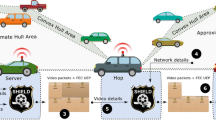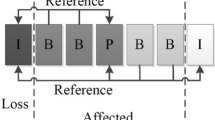Abstract
The adoption of video-equipped vehicles in Vehicular ad-hoc networks (VANETs) is experiencing a rapid growth. It is also anticipated a substantial increase in the video content distribution with the arrival of self-driving cars as both passengers and vehicles will be able to produce and consume this type of media. This unveils a set of challenges, especially in VANETs where the network resources tend to be scarce and the connections suffer from time-varying error conditions. Taking everything into consideration, a Quality of Experience (QoE)-driven mechanism is desirable to enhance the video delivery over error-prone networks. To this end, the combined use of forward error correction and unequal error protection has proven its efficiency in delivering high-quality videos with low network overhead. The proposed intelligent quality-driven and network-aware mechanism (AntArmour) uses an ant colony optimization scheme to dynamically allocate a precise amount of redundancy. This allows AntArmour to safeguard, in real-time, the live transmission of high-resolution video streams. This operation is performed according to specific high efficiency video coding details and the actual network conditions such as the signal-to-noise ratio, the network density, the vehicle’s position, and the current packet loss rate (PLR) as well as the prediction of future PLR. The experiments were performed using real map’s clippings and actual video footage. The assessment was performed with the aid of two well-known objective QoE metrics, as well as the measure of the network overhead. The results showed that the proposed mechanism outperformed all its competitors in both video quality improvement and network overhead decrement.








Similar content being viewed by others
References
comScore: Brazilian online video audience reaches 43 million unique viewers in december 2012. Technical report, comScore inc. (February 2013). http://www.comscore.com/Insights/Press_Releases/2013/2/Brazilian_On-line_Video_Audience_Reaches_43_Million_Unique_Viewers_in_December_2012.
Adobe Digital Index: U.S. digital video benchmark report. Technical report, Adobe (Q2 2014).
Cisco: White paper: Cisco VNI forecast and methodology, 2015–2020. Technical report, Cisco (June 2016). http://www.cisco.com/c/en/us/solutions/collateral/service-provider/visual-networking-index-vni/complete-white-paper-c11-481360.html.
Cisco: White paper: Cisco VNI forecast and methodology, 2016-2021. Technical report, Cisco (September 2017). http://www.cisco.com/c/en/us/solutions/collateral/service-provider/visual-networking-index-vni/complete-white-paper-c11-481360.html
Zhou, L., Zhang, Y., Song, K., Jing, W., & Vasilakos, A. V. (2011). Distributed media services in p2p-based vehicular networks. IEEE Transactions on Vehicular Technology, 60(2), 692–703.
Gerla, M., Wu, C., Pau, G., & Zhu, X. (2014). Content distribution in VANETs. Vehicular Communications, 1(1), 3–12. https://doi.org/10.1016/j.vehcom.2013.11.001.
Immich, R., Cerqueira, E., & Curado, M. (2015). Shielding video streaming against packet losses over vanets. Wireless Networks, 1–15. https://doi.org/10.1007/s11276-015-1112-z.
Immich, R., Cerqueira, E., & Curado, M. (2016). Towards a qoe-driven mechanism for improved h.265 video delivery. In 2016 Mediterranean Ad Hoc Networking Workshop (Med-Hoc-Net) (pp. 1–8). https://doi.org/10.1109/MedHocNet.2016.7528427.
Soldo, F., Casetti, C., Chiasserini, C., & Chaparro, P. A. (2011). Video streaming distribution in vanets. IEEE Transactions on Parallel and Distributed Systems, 22(7), 1085–1091. https://doi.org/10.1109/TPDS.2010.173.
Jiang, T., Wang, H., & Vasilakos, A. V. (2012). Qoe-driven channel allocation schemes for multimedia transmission of priority-based secondary users over cognitive radio networks. IEEE Journal on Selected Areas in Communications, 30(7), 1215–1224.
Bellalta, B., Belyaev, E., Jonsson, M., & Vinel, A. (2014). Performance evaluation of ieee 802.11p-enabled vehicular video surveillance system. IEEE Communications Letters, 18(4), 708–711. https://doi.org/10.1109/LCOMM.2014.022514.140206.
Immich, R., Cerqueira, E., & Curado, M. (2015). Adaptive qoe-driven video transmission over vehicular ad-hoc networks. In IEEE conference on computer communications workshops (INFOCOM WKSHPS).
Marwaha, S., Srinivasan, D., Tham, C. K., & Vasilakos, A. (2004). Evolutionary fuzzy multi-objective routing for wireless mobile ad hoc networks. In CEC2004 Congress On Evolutionary Computation (Vol. 2, pp. 1964–1971). IEEE.
Zeng, Y., Xiang, K., Li, D., & Vasilakos, A. V. (2013). Directional routing and scheduling for green vehicular delay tolerant networks. Wireless Networks, 19(2), 161–173.
Pham, T. A. Q., Piamrat, K., & Viho, C. (2014). Qoe-aware routing for video streaming over vanets. In IEEE 80th Vehicular Technology Conference (VTC Fall) (pp. 1–5). https://doi.org/10.1109/VTCFall.2014.6966141.
Wu, H., & Ma, H. (2014). Opportunistic routing for live video streaming in vehicular ad hoc networks. In IEEE 15th international symposium on a world of wireless, mobile and multimedia networks (WoWMoM) (pp. 1–3). https://doi.org/10.1109/WoWMoM.2014.6919002.
Zhang, X. M., Zhang, Y., Yan, F., & Vasilakos, A. V. (2015). Interference-based topology control algorithm for delay-constrained mobile ad hoc networks. IEEE Transactions on Mobile Computing, 14(4), 742–754.
Nafaa, A., Taleb, T., & Murphy, L. (2008). Forward error correction strategies for media streaming over wireless networks. IEEE Communications Magazine, 46(1), 72–79. https://doi.org/10.1109/MCOM.2008.4427233.
Immich, R., Borges, P., Cerqueira, E., & Curado, M. (2015). Qoe-driven video delivery improvement using packet loss prediction. International Journal of Parallel, Emergent and Distributed Systems, 30(6), 478–493.
Dorigo, M., Maniezzo, V., & Colorni, A. (1996). Ant system: Optimization by a colony of cooperating agents. IEEE Transactions on Systems, Man, and Cybernetics, Part B: Cybernetics, 26(1), 29–41.
Sullivan, G. J., Ohm, J.-R., Han, W.-J., & Wiegand, T. (2012). Overview of the high efficiency video coding (hevc) standard. IEEE Transactions on Circuits and Systems for Video Technology, 22(12), 1649–1668.
Asefi, M., Mark, J. W., & Shen, X. (2012). A mobility-aware and quality-driven retransmission limit adaptation scheme for video streaming over vanets. IEEE Transactions on Wireless Communications, 11(5), 1817–1827. https://doi.org/10.1109/TWC.2012.030812.111064.
Talari, A., Kumar, S., Rahnavard, N., Paluri, S., & Matyjas, J. (2013). Optimized cross-layer forward error correction coding for h.264 avc video transmission over wireless channels. EURASIP Journal on Wireless Communications and Networking, 2013(1), 1–13.
Rezende, C., Almulla, M., & Boukerche, A. (2013). The use of erasure coding for video streaming unicast over vehicular ad hoc networks. In IEEE 38th conference on local computer networks (LCN) (pp. 715–718). https://doi.org/10.1109/LCN.2013.6761318.
Naeimipoor, F., & Boukerche, A. (2014). A hybrid video dissemination protocol for vanets. In IEEE International conference on communications (ICC) (pp. 112–117). https://doi.org/10.1109/ICC.2014.6883304
Huynh-Thu, Q., & Ghanbari, M. (2008). Scope of validity of PSNR in image/video quality assessment. Electronics Letters, 44, 800–8011.
Vlavianos, A., Law, L. K., Broustis, I., Krishnamurthy, S. V., & Faloutsos, M. (2008). Assessing link quality in ieee 802.11 wireless networks: Which is the right metric? In IEEE 19th international symposium on personal, indoor and mobile radio communications, PIMRC 2008 (pp. 1–6). https://doi.org/10.1109/PIMRC.2008.4699837.
Wan, Z., Xiong, N., & Yang, L. (2015). Cross-layer video transmission over IEEE 802.11e multihop networks. Multimedia Tools and Applications, 74(1), 5–23. https://doi.org/10.1007/s11042-013-1447-3.
Martini, M. G., Mazzotti, M., Lamy-Bergot, C., Huusko, J., & Amon, P. (2007). Content adaptive network aware joint optimization of wireless video transmission. IEEE Communications Magazine, 45(1), 84–90. https://doi.org/10.1109/MCOM.2007.284542.
Immich, R., Cerqueira, E., & Curado, M. (2013). Cross-layer FEC-based mechanism for packet loss resilient video transmission. In Biersack, E., Callegari, C., Matijasevic, M. (Eds.) Data Traffic Monitoring and Analysis. Lecture Notes in Computer Science (Vol. 7754, pp. 320–336). Berlin: Springer. https://doi.org/10.1007/978-3-642-36784-7_13.
Immich, R., Cerqueira, E., & Curado, M. (2014). Towards the enhancement of uav video transmission with motion intensity awareness. In Wireless Days (WD), 2014 IFIP.
Dorigo, M., Birattari, M., & Stutzle, T. (2006). Ant colony optimization. IEEE Computational Intelligence Magazine, 1(4), 28–39.
Gutjahr, W. J. (2000). A graph-based ant system and its convergence. Future Generation Computer Systems, 16(8), 873–888. https://doi.org/10.1016/S0167-739X(00)00044-3.
Greengrass, J., Evans, J., & Begen, A. C. (2009). Not all packets are equal, part i: Streaming video coding and SLA requirements. IEEE Internet Computing, 13, 70–75. https://doi.org/10.1109/MIC.2009.14.
Bentley, J. L., Preparata, F. P., & Faust, M. G. (1982). Approximation algorithms for convex hulls. Communications of the ACM, 25(1), 64–68. https://doi.org/10.1145/358315.358392.
Henderson, T. R., Roy, S., Floyd, S., & Riley, G. F. (2006). Ns-3 project goals. In Proceeding from the 2006 workshop on Ns-2: The IP network simulator. WNS2 ’06. ACM, New York, NY, USA. https://doi.org/10.1145/1190455.1190468.
Breslau, L., Estrin, D., Fall, K., Floyd, S., Heidemann, J., Helmy, A., et al. (2000). Advances in network simulation. IEEE Computer, 33(5), 59–67.
Klaue, J., Rathke, B., & Wolisz, A. (2003). EVALVID—A framework for video transmission and quality evaluation. In International conference on modelling techniques and tools for computer performance evaluation (pp. 255–272).
Xiph.Org: Xiph.org Video Test Media (derf’s collection). Retrieved February 18, 2016 from http://media.xiph.org/video/derf/
Staelens, N., Sedano, I., Barkowsky, M., Janowski, L., Brunnstrom, K., & Le Callet, P. (2011). Standardized toolchain and model development for video quality assessment—The mission of the joint effort group in VQEG. In Quality of Multimedia Experience (QoMEX) (pp. 61–66). https://doi.org/10.1109/QoMEX.2011.6065713.
ITU-T J.247: Objective Perceptual multimedia video quality measurement in the presence of a full reference. Recommendation J.247. International Telecommunications Union.
Eichler, S. (2007). Performance evaluation of the IEEE 802.11p wave communication standard. In IEEE 66th vehicular technology conference, VTC-2007 Fall. (pp. 2199–2203). IEEE
Jiang, D., & Delgrossi, L. (2008). IEEE 802.11p: Towards an international standard for wireless access in vehicular environments. In IEEE vehicular technology conference, VTC Spring 2008 (pp. 2036–2040). IEEE. https://doi.org/10.1109/VETECS.2008.458.
Katsaros, K., Dianati, M., Tafazolli, R., & Kernchen, R. (2011). CLWPR—A novel cross-layer optimized position based routing protocol for vanets. In IEEE vehicular networking conference (VNC) (pp. 139–146). https://doi.org/10.1109/VNC.2011.6117135
Behrisch, M., Bieker, L., Erdmann, J., & Krajzewicz, D. (2011). Sumo–simulation of urban mobility. In The 3rd International Conference on Advances in System Simulation (SIMUL 2011). Barcelona, Spain.
Mittag, J., Papanastasiou, S., Hartenstein, H., & Strom, E. G. (2011). Enabling accurate cross-layer PHY/MAC/NET simulation studies of vehicular communication networks. Proceedings of the IEEE, 99(7), 1311–1326. https://doi.org/10.1109/JPROC.2010.2103291.
Taliwal, V., Jiang, D., Mangold, H., Chen, C., & Sengupta, R. (2004). Empirical determination of channel characteristics for dsrc vehicle-to-vehicle communication. In Proceedings of the 1st ACM international workshop on vehicular ad hoc networks, VANET ’04 (pp. 88–88). New York, NY: ACM. https://doi.org/10.1145/1023875.1023890.
Winkler, S., & Mohandas, P. (2008). The evolution of video quality measurement: From PSNR to hybrid metrics. IEEE Transactions on Broadcasting, 54(3), 660–668. https://doi.org/10.1109/TBC.2008.2000733. IEEE Broadcast Technology Society.
Pinson, M. H., & Wolf, S. (2004). A new standardized method for objectively measuring video quality. IEEE Transactions on broadcasting, 50(3), 312–322.
Wang, Z., Bovik, A. C., Sheikh, H. R., & Simoncelli, E. P. (2004). Image quality assessment: From error visibility to structural similarity. IEEE Transactions on Image Processing, 13(4), 600–612. https://doi.org/10.1109/TIP.2003.819861.
Chikkerur, S., Sundaram, V., Reisslein, M., & Karam, L. J. (2011). Objective video quality assessment methods: A classification, review, and performance comparison. IEEE Transactions on Broadcasting, 57(2), 165–182. https://doi.org/10.1109/TBC.2011.2104671.
Vatolin, D., Moskin, A., Pretov, O., Trunichkin, N. MSU video quality measurement tool. Retrieved February 18, 2016 from http://compression.ru/video/quality_measure/video_measurement_tool_en.html
Acknowledgements
This work was funded by the Brazilian National Counsel of Technological and Scientific Development (CNPq), and also supported by the MobiWise: from mobile sensing to mobility advising project (P2020 SAICTPAC/0011/2015), and DenseNet: Efficient communication in dense networks project (PTDC/EEI-SCR/6453/2014 POCI-01-0145-FEDER-016777), and The LUSO-AMERICAN Development Foundation grant (Proj. 172/2016).
Author information
Authors and Affiliations
Corresponding author
Rights and permissions
About this article
Cite this article
Immich, R., Cerqueira, E. & Curado, M. Efficient high-resolution video delivery over VANETs. Wireless Netw 25, 2587–2602 (2019). https://doi.org/10.1007/s11276-018-1687-2
Published:
Issue Date:
DOI: https://doi.org/10.1007/s11276-018-1687-2




